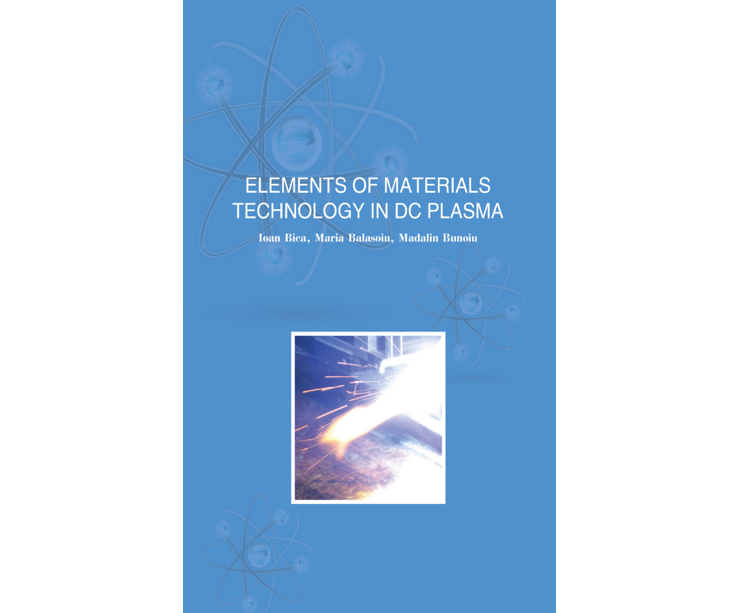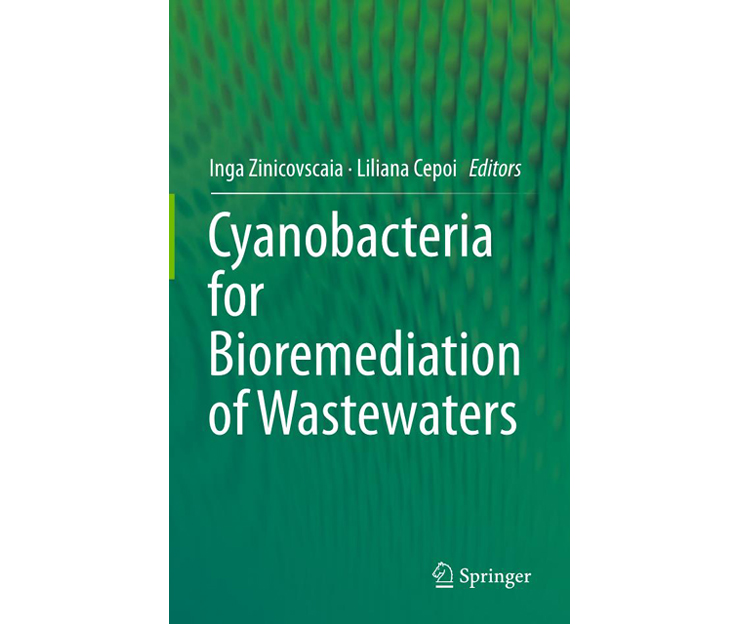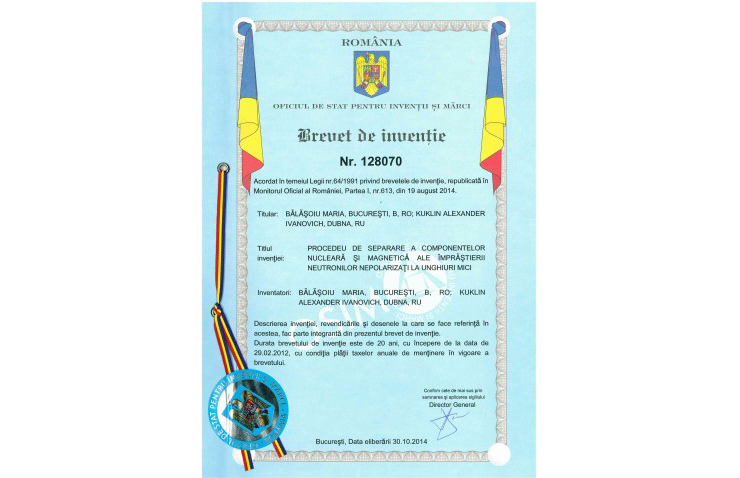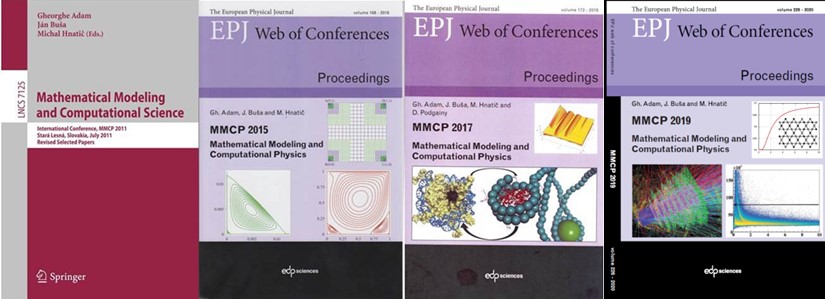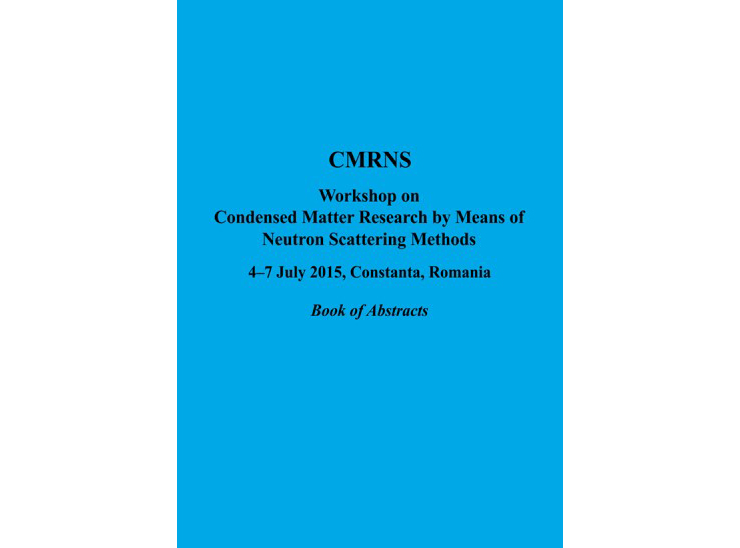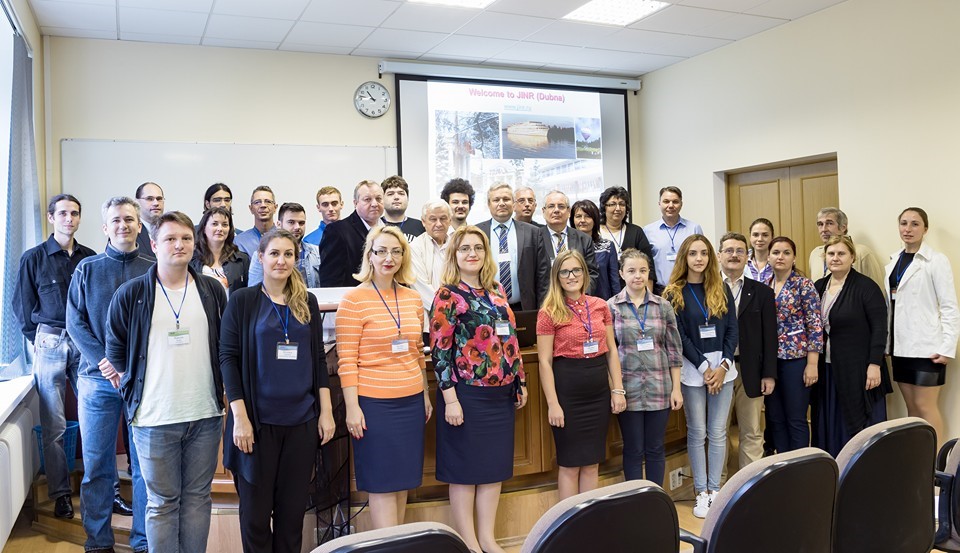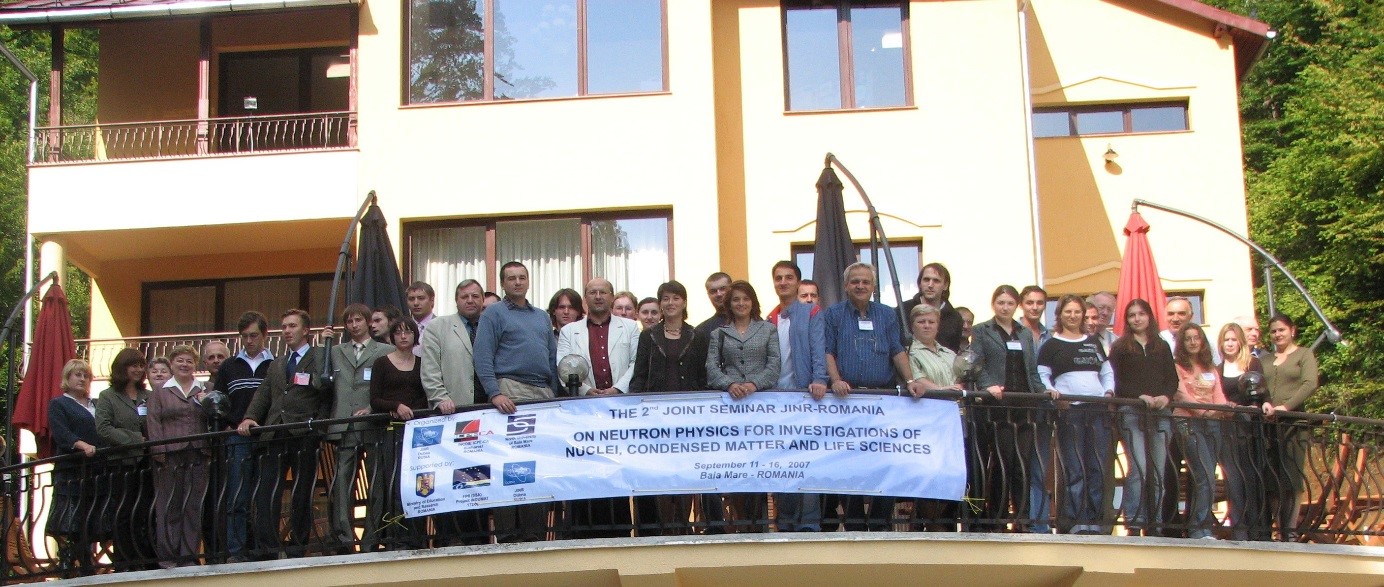General information on collaboration
Romania was one of the founder states of the Joint Institute for Nuclear Research (JINR) since 26 March 1956.
Romania is one of the important JINR Member States in the amount of participation in the JINR activities, joint research, and scientific and technological relations. The basis of the Romanian participation to the Joint Institute for Nuclear Research was laid down by the famous Romanian scientist, Academician Horia Hulubei. During the first decades of the JINR, outstanding contributions to the JINR activity were brought by the Romanian scientists, Academicians Șerban Țițeica, Ioan Ursu, and Aureliu Săndulescu, Professor Alexandru Mihul.
Romanian physicists actively participated in scientific research of the Institute. Well known Romanian scientists contributed to the management of the Institute and of its laboratories:
JINR Vice Directors:
- Șerban Țițeica – 1962–1964
- Alexandru Mihul — 1970–1973
- Aureliu Săndulescu — 1983–1986
- LHE Deputy Director Ovidiu Balea — 1975–1978
- FLNR Deputy Director Aureliu Sandulescu — 1974–1977
- FLNP Deputy Director Nicolae Popa — 2002–2006
- LIT Deputy Director Gheorghe Adam — 2003–2009
- LIT Deputy Director Sanda Adam — 2009–2013
- LIT Deputy Director Gheorghe Adam — 2013–2018
- FLNP Deputy Director Otilia Culicov — 2013–till now
In recognition of the merits of the Romanian scientists to the JINR development, on the occasion of the 40th Anniversary of the Joint Institute, the Committee of the Member States Plenipotentiary Representatives decided on 25 March 1996 to name alleys on the Institute laboratory grounds in honour of the eminent scientists Horia Hulubei and Șerban Țițeica.
While often expressing specific positions on JINR practical matters, Romania has always recognized the JINR importance for the development of its national centres, for the development of the mutual collaboration.
The two-sided JINR–Romania cooperation reflects the general fact that many scientific problems dealt with at JINR are being solved in close cooperation with research centres of JINR Member States and, vice versa, many problems tackled in the JINR Member States are being solved with assistance of the Joint Institute for Nuclear Research. Concerning the past, we can emphasize the high interest of the Romanian scientists for heavy-ion physics in the seventies-eighties of the past century. Romania actively took part in the buildup of the FLNR cyclotron complex. In particular, in Romania, there was made the transportation system with extracted beams of the U-400 accelerator. Magnetic elements of beam transportation lines for all FLNR accelerators and experimental set-ups were manufactured in Romania. Romanian physicists are actively involved in experiments, processing and interpretation of results on the nuclear structure and mechanisms of reactions.
The round-table “Romania at JINR”, held as a part of the Scientific JINR Council in June 2003, was done with the participation of a representative delegation from all large Romanian cities involved in cooperation with JINR.
The birthday centenary of the outstanding Romanian scientist Șerban Țițeica, included in the UNESCO recommendations for 2008, was celebrated in JINR with attendance of H.E. Constantin Mihail Grigorie, Ambassador Extraordinary and Plenipotentiary of Romania to the Russian Federation.
At the end of the November 2010 Session of the Committee of the Plenipotentiary Representatives at JINR, the National day of Romania was celebrated with the attendance of the Romanian Ambassador and the Plenipotentiary Representative of the Romanian Government at JINR. For the first time, a week of the Romanian cinema was organized in Dubna by the Romanian Institute of Culture.
Three Joint JINR-Romania seminar-schools on neutron physics for investigations of nuclei, condensed matter and life sciences were organized in 2002, 2007 and 2011 by JINR in collaboration with Romanian scientific and high education institutions under the auspices and financial support of Plenipotentiary of Romanian Government at JINR and Romanian Ministry of Education and Science. The Romanian students and young researchers had the opportunity to listen to lectures given by leading scientists of the Frank Laboratory of Neutron Physics and outstanding Romanian Professors and Academicians.
Specific items concerning the cooperation are defined in two-sided protocols for joint research.
The two joint programmes (Țițeica-Markov in theoretical physics and Hulubei-Meshcheryakov in information technologies and computational physics) and the about 100 periodically renewed protocols signed with all the JINR laboratories and the JINR University Center are the compulsory basis for the approval of the grant and project proposals of the Plenipotentiary Representative of the Romanian Government at JINR. Through this mechanism, all the significant Romanian centers are involved in the cooperation with the JINR.
The backbone of the cooperation is secured by the long-term hired Romanian scientists in JINR. During the last decade, their number was maintained at a level of about 20 people, both experienced and young. JINR is a very good place for starting scientific careers. Successful recent instances of young Romanian scientists who have started working in JINR and acquired master and/or PhD : Dr.titles: Eugen Anitas (Head of Sector in BLTP since 2014), Dr Inga Zinicovscaia (Head of Sector in FLNP since 2019), Dr Raul Erhan (formerly senior researcher in FLNP, now postdoc fellow in IET, Kjeller, Norway), Dr Mihaela Paraipan (Senior researcher in VBLHEP), Dr Horia Pasca (formerly at BLTP – Nuclear Physics, now Lecturer at Babes-Bolyai Univ., Romania), Dr Iulia Harca (formerly at FLNR – Synthesis of Super heavy elements, now at IFIN-HH, Romania), Dr Cristina Oancea (DLNP – Proton therapy), Ioana Caracas (formerly at DLNP, continues now her doctoral studies at Univ. Wuppertal, Germany).
Specialists from Romanian institutes come on short-term visits to the JINR laboratories for carrying out joint research and participation in international conferences, and JINR scientists regularly go to Romania for joint scientific activities, to international conferences and schools. It should be emphasized the significant contribution of LIT-JINR scientists and specialists to the development of the WLCG Grid infrastructure in Romania. Both the LIT and Romanian scientists actively contribute to the periodic Grid Conferences organized in JINR and Romania.
Romania is a hospitable host of JINR scientists participating in traditional schools and international conferences. Since its first 1964 edition, the “Carpathian Summer School of Physics” has regularly had keynote speakers coming from JINR. At its 27th edition in June-July 2016, a special round table was devoted to the 60th JINR Anniversary.
A traditional form of involvement of JINR in the growth of young Romanian scientists is their participation in educational programs at JINR. Since the seventies of the past century, groups of senior Romanian students regularly do their summer practice at JINR laboratories. During the last years, their number has significantly grown up, reaching 20 students in the last three years. There is a vivid interest of the Romanian young people in the important form of new cooperation, defined within the JINR Summer Student Program. Romanian students and young scientists are regularly attending the annual JINR International Scientific Conference of the Young Scientists and Specialists and their presentations are highly appreciated during the competition associated to this event.
-

Vladimir V. Korenkov
Executive of the contacts with Romania, MLIT Scientific Leader. -

+7 (496) 216-25-26
-

The scientists of Romania take part in the research work on the following themes of the Topical plan for JINR research and international cooperation for the year 2025:
- Theoretical Physics
Cooperation on 2 themes. - Elementary Particle Physics and High-Enegry Heavy-Ion Physics
Cooperation on 5 themes. - Nuclear physics
Cooperation on 2 themes.
There are currently 34 Romanian institutes and universities doing research in collaboration with JINR. The most active partners:
- Horia Hulubei National Institute for R&D in Physics and Nuclear Engineering – IFIN-HH (Bucharest) (19 themes)
- University of Bucharest – UB (Bucharest) (9 themes)
- National Institute for Research and Development in Electrical Engineering (INCDIE ICPE-CA) (Bucharest) (6 themes)
- Institute of Space Science – ISS (Bucharest) (8 themes).
The “Extreme Light Infrastructure – Nuclear Physics (ELI-NP)”, in final implementation stage in Bucharest-Măgurele, under the leadership of Acad. Nicolae Victor Zamfir, the Plenipotentiary Representative of the Romanian Government at JINR during 2005-2016, is going to be the most advanced research facility in the world focusing on the study of photonuclear physics and its applications, comprising a very high intensity laser of two 10PW ultra-short pulse lasers and the most brilliant tunable gamma-ray beam.
This unique experimental combination will enable ELI-NP to tackle a wide range of research topics in fundamental physics, nuclear physics and astrophysics, and also applied research in materials science, management of nuclear materials and life sciences.
ELI-NP has been selected by the most important science committee in Nuclear Physics in Europe – NuPECC – in the Nuclear Physics Long Range Plan in Europe as a major facility.
The Memorandum of Scientific Collaboration on the implementation of the Extreme Light Infrastructure – Nuclear Physics (ELI-NP) Project and the Nuclotron-based Ion Collider fAсility (NICA) Project between the “Horia Hulubei” National Institute of Physics and Nuclear Engineering and the Joint Institute for Nuclear Research was signed during the meeting of the JINR Directorate with leaders of the Ministry of Research and Innovation of Romania on 20 November 2018. The memorandum is aimed to become the basis for development of cooperation between the scientific centres in the frames of developing the ELI-NP and NICA experimental areas as well as defining the experimental programmes of the projects.
Joint JINR-Romania publications – around 200 scientific articles (around 180 in ISI journals) per year, containing specific contributions of Romanian authors in:
- investigation of the confinement/deconfinement phase transitions in dense hadronic matter within the NICA/MPD and BM@N experiments;
- nuclear fission, quasi-fission and multinucleon transfer aimed at defining new ways of obtaining heavy and superheavy nuclei at the DRIBS-III facility;
- physical analysis with high performance detectors of various-type materials (nano, intelligent, vesicular etc) subject to neutron irradiation at the IBR-2M reactor;
- environmental studies based on samples collected in various ecosystems;
- development of new theoretical models for the characterization of phase transitions occurring in new materials or in nuclear processes;
- development of top computing infrastructure facilities requested by the current and perspective large scale research projects;
- development of new approaches and methods in numerical analysis for the computation of physical observables with controlled accuracy;
- new approaches aimed at reducing the risks of the hadron therapy in oncological diseases;
- development of new sample environmental equipment which extend technical capabilities for investigation of condensed matter in extreme conditions by means of neutrons.
JINR Prizes awarded to Romanian researchers for significant contributions in:
Theoretical Physics Research
- “Cluster approach for describing nuclear fission” – H. Pasca, G. Adamian, A. Andreev, N. Antonenko, R. Jolos, A. Nasirov, T. Shneidman (1st Prize, 2016)
- “Theory of Spin Fluctuations and High-Temperature Superconductivity in Cuprates” – N. Plakida, S. Adam, Gh. Adam, A. Vladimirov, D. Ihle, V.Oudovenko (1st Prize, 2013).
Experimental Physics Research
- “Magnetic phenomena in intermetallic compounds RCo2: studies of the limits of the itinerant electron metamagnetism concept” – D. Kozlenko, E.Lukin, S. Kichanov, A. Rutkauskas, B. Savenko, E. Burzo, P. Vlaic, Dang Ngoac Toan (1st Prize, 2016)
Applied Physics Research
- “Determination of the elemental content of Moldavian wines and soils by neutron activation analysis”- I. Zinicovscaia, O. Culicov, M. Frontasyeva, S. Gundorina, O. Duliu, R. Sturza (2nd Prize, 2018)
- “Neutron activation analysis for ecological state assessment of coastal ecosystems of the Black Sea” – A. Kravtsova, P. Nekhoroshkov, M. Frontasyeva, I. Zinicovscaia, N. Yushin, O. Bunkova, I. Stukolova, A. Yakovlev, A. Kamnev (2nd Prize, 2016)
- “Neutron activation analysis in wastewater treatment” – I. Zinicovscaia, M. Frontasyeva, O. Culicov, S. Pavlov, S. Gundorina, L. Cepoi, T. Chiriac, L. Rudi, A. Valuta, T. Mitina (Encouraging Prize, 2015)
- “Structure and Properties of Magnetic Nanoparticles Produced by Bacteria Klebsiella oxytoca: Comprehensive Research and Experimental Validation of Biomedical Applications” – M. Balasoiu, D. Soloviov, A. Rogachev, L. Anghel, O. Orelovich, L. Ishchenko, S. Stolyar, R. Iskhakov, Yu. Raikher (Encouraging Prize, 2014)
Physics Instruments and Methods
- “Structure of deterministic mass, surface and multiphase fractals: theory and methods of analysing the intensity of small-angle scattering” – A.Cherny, E. Anitas, V. Osipov, A. Kuklin, M. Balasoiu (2nd Prize, 2017)
Books:
- “Small-Angle Scattering (Neutrons, X-Rays, Light) from Complex Systems: Fractal and Multifractal Models for Interpretation of Experimental Data” by Eugen Mircea Anitas, Springer, Cham, Switzerland, 2019, ISBN 978-3-030-26612-7, https://www.springer.com/gp/book/9783030266110. This book addresses the basic physical phenomenon of small-angle scattering (SAS) of neutrons, x-rays or light from complex hierarchical nano- and micro-structures. The emphasis is on developing theoretical models for the material structure containing self-similar or fractal clusters. Within the suggested framework, key approaches for extracting structural information from experimental scattering data are investigated and presented in detail. The range of parameters which can be obtained pave the road towards a better understanding of the correlations between geometrical and various physical properties (electrical, magnetic, mechanical, optical, dynamical, transport etc.) in fractal nano- and micro-materials.
- “Elements of Materials Technology in DC plasma” by Ioan Bica, Maria Balasoiu, Madalin Bunoiu, ISBN 978-5-94836-485-8, Technosphera JSC Publishing House, Moscow, 2017, 445 p. http://www.technosphera.ru/lib/book/512. The present book comprises two, apparently, distinct parts. In the first part, in an accessible mathematical language, elements of the theory of metallurgical processes using DC plasma (Chapters 1 to 11) are presented. The second part of the book provides elements of processing and manufacturing technology of semi-products, waste incineration by plasma and electric arc, particles spheroidization and producing in plasma of nano-micro systems (micro-nano particles, micro-nano tubes and hollow micro-particles) useful in biomedical and technical applications (Chapters 12 to 27). The book emerged as the result of the cooperation between the Physics Department of the West University of Timisoara (Romania) and Frank Laboratory of Joint Institute for Nuclear Research from and is addressed especially to students, PhD students and scientists interested in this topic.
- “Modern Trends of Nanoscience”, (Eds. M.Balasoiu, A.G. Arzumanian), ISBN 978-973-27-2230-5, Publishing House of Romanian Academy, Bucharest, 2013, 236p. The present volume, Modern Trends in Nanoscience, represents a collection of 13 specialized review articles, both theoretical and experimental, that attempt to highlight recent developments of the Joint Institute for Nuclear Research, Dubna, and its Romanian colleagues in the field of nanoscience research.
- “Cyanobacteria for Bioremediation of Wastewaters”, Springer 2016, ISBN 978-3-319-26751-7. Editors: Zinicovscaia, Inga, Cepoi, Liliana. This book reflects the use of cyanobacteria for the bioremediation of wastewater through different mechanisms and pathways of transformation and transfer of hazardous substances from one medium to another. The application of microorganisms for bioremediation is determined by their ubiquity, small size, high rate of reproduction and large surface-to-volume cell ratio. Mechanisms of interaction of cyanobacteria with inorganic pollutants include biosorption, bioaccumulation with an opportunity to obtain metal nanoparticles both on the cell surface and inside the cells as well as chelation and inclusion of metals in the composition of certain organic structures. Data presented in the book provides specialists in the field with useful information for bioremediation technologies as well as for obtaining valuable preparations using cyanobacteria.
Patents: Patent RO 128070 Method for separating the nuclear and magnetic contributions of small-angle scattering of unpolarized neutrons
Reports presented at JINR Scientific Council by young Romanian scientists (as recommended by JINR Programme Advisory Committees):
- Feb. 2020: I. Zinicovscaia (FLNP/IFIN-HH) “Neutron activation analysis as a tool for tracing the accumulation of silver nanoparticles in tissues of female mice and their offspring”
- Sept. 2018: I. Harca (FLNR/IFIN-HH Bucharest) “Fusion-fission and quasi-fission in the near-barrier reaction of 32S + 197Au”
- Feb. 2016: H. Paşca (BLTP/UBB Cluj-Napoca) “Energy dependence of mass, charge, isotopic distributions and TKE in neutron-induced fission of 235U and 239Pu”
- Sept. 2013: E.M. Anitas (BLTP) “Small-angle scattering from multi-phase systems: investigation of the crossover between Porod and fractal regimes”
Scientific reports presented at JINR Programme Advisory Committees by Romanian scientists
June 2019: A. Parvan (BLTP/IFIN-HH): “Transverse momentum distributions of hadrons in the Tsallis nonextensive statistics” PAC for Nuclear Physics
The Scientific Council endorsed the proposals of the JINR Directorate to award the title “Honorary Doctor of JINR”, in recognition of their outstanding contributions to the advancement of science and the education of young scientists, to Professors:
- Sept. 2015: V. Fortov (Russia), P. Fré (Italy), R.-D. Heuer (Germany), J. Khubua (Georgia), Yu. Oganessian (Russia), H. Stöcker (Germany), I. Tighineanu (Moldova), and N.V. Zamfir (Romania).
- Sept. 2014: B. Sharkov (Russia), Gh. Stratan (Romania), and Tran Thanh Van (Vietnam/France).
Organization of Joint International Conferences (with outstanding Conference Proceedings and training Schools)
- Mathematical Modeling and Computational Physics (MMCP) International Conference Series, under joint organization (since 2011) of LIT in JINR, several Slovak institutions in Košice and IFIN-HH in Romania.
Left: With over 47,000 downloads of the 41 accepted papers at the mid-2020, at a pace of over 500 monthly, the LNCS 7125 volume was annually quoted by Springer since 2013 as one of its top 50% most downloaded eBooks in this collection. The following link points to 123 citations and 47k downloads: https://link.springer.com/book/10.1007/978-3-642-28212-6
Centre-left: EPJ-WoC, Vol.108 (2016), with 58 accepted papers: http://www.epj-conferences.org/articles/epjconf/abs/2016/03/contents/contents.html
Centre-right: EPJ-WoC, Vol.173 (2018), with 100 accepted papers: https://www.epj-conferences.org/articles/epjconf/abs/2018/08/contents/contents.html
Right: EPJ-WoC, Vol.226 (2020), with 48 accepted papers: https://www.epj-conferences.org/articles/epjconf/abs/2020/02/contents/contents.html - Distributed Computing and Grid-technologies in Science and Education (GRID) International Conference Series organized every two years, since 2004, by LIT in JINR and sponsored among others by Romanian grants. Remarkable features of both MMCP and GRID Conferences were their growing audiences (over 250 participants) and satellite intensive Training Schools organized on hot topics for doctoral students and young scientists (over 50 participants at the last two editions).
- The first International Summer School and Workshop “Complex and Magnetic Soft Matter Systems: Physico-Mechanical Properties and Structure” (CMSMS’12) took place from 3 to 7 September 2012 in Alushta. It has brought together 32 specialists (top-level experts and young researchers) from Russia, Romania, Moldova, Belarus, Ukraine, France and Germany working on interdisciplinary problems in soft matter. Their contributions totalled 37 works. The main organizers: JINR, West University of Timisoara, Institute of Continuous Media Mechanics of Russian Academy of Sciences (Perm).
- The second and third editions of CMSMS, schools and workshops have been jointly organized by JINR, West University of Timișoara, IFIN-HH, Romanian Society of Physics and other institutions, Editions 2014 and 2017 (Proceedings published in Journal of Physics: Conference Series, Vol 994 (2018), Eds. Yu. Raikher, M. Bălăşoiu, A. Rogachev, M. Bunoiu; 17 accepted papers).
- Workshop on Condensed Matter Research by Means of Neutron Scattering Methods (CMRNS): First CMRNS event was organized as a joint event of the 15th International Balkan Workshop on Applied Physics and Materials Science (IBWAP 2015), hosted by Ovidius University of Constanta, and supported by the Balkan Physical Union, the Romanian Physical Society, Romanian Academy, Academy of Romanian Scientists, and Joint Institute for Nuclear Research from Dubna. The CMRNS topic highlights the results of interdisciplinary research including condensed matter physics, material science, soft matter, life and earth sciences, as well as the development of neutron instruments and techniques at IBR-2 reactor. The participants were composed of 14 lecturers from JINR and Romania, and listener scientists from different Romanian universities and research institutes and students, presenting 16 poster presentations.
- 2ndCMRNS event was organized as a joint event of the 17th International Balkan Workshop on Applied Physics and Materials Science (IBWAP 2017). 16 lectures and 13 posters have been presented. The main objective of CMRNS is to offer overviews, reports on new results on several important research issues in the field and to provide opportunities for cooperation developments.
- First Student Training Course: Advanced Materials Investigation by Means of Neutron Scattering Methods, 27 August – 4 September 2016, JINR, Dubna was organized by FLNP-JINR, WUT (Timisoara) and OUC (Constanta). The participants: A group of 20 students and professors from the Faculty of Physics of the West University of Timisoara and from the Faculty of Applied Sciences of Ovidius University from Constanta Romania; students performing the Summer practice in our Department from Dubna University; students from Moscow National Research Nuclear University and Lomonosov Moscow State University; young researchers from FLNP-Condensed Matter Department.
- 2nd Student Training Course Neutron Scattering in Condensed Matter Physics, was organized by JINR (Dubna) and PNPI KI (Gatchina), Sankt-Petersburg State University, WUT (Timisoara) and OUC (Constanta) and as a satellite event of the National Conference on Neutron Scattering in Condensed Matter (NSCM-2018), the 15 – 22 September 2018, in Peterhof, Russia. The participants: a group of 19 Romanian students, teachers and researchers from West University of Timisoara, Ovidius University from Constanta and Horia Hulubei National Institute of Physics and Nuclear Engineering, Bucharest.
Since 21-st of July 2016, the Plenipotentiary Representative of the Government of Romania at JINR is Dr. Florin-Dorian Buzatu, the Director General (since 2008) of the Institute of Atomic Physics (IFA), Măgurele-Bucharest, Romania.
Florin-Dorian Buzatu was born on 17-th April 1957. He graduated from the Faculty of Physics of the University of Bucharest in 1982 with the specialization in nuclear physics. His doctoral thesis “Contributions to the study of the one-dimensional Hubbard model” was defended in 1994 at the Institute of Atomic Physics (IFA). His main scientific interests have been related to the theory of condensed matter physics: strongly correlated electrons, one-dimensional fermionic models, phase transitions in electron and molecular systems.
His current management tasks include the coordination of the Research and Development (R&D) programmes supporting the Romanian participation in European projects and collaborations (EURATOM, F4E, CERN, ELI-NP, FAIR, CEA). He has brought a significant contribution to the coordination of the preparation of the Romania’s Application file for hosting the Extreme Light Infrastructure (ELI) during the ELI Preparatory Phase (2008-2010).
His professional career started at Horia Hulubei National Institute for R&D in Physics and Nuclear Engineering in Bucharest-Magurele (IFIN-HH). He has grown as a prominent scientist and a R&D management leader within IFIN-HH, with which he remained closely associated over the years. In his capacity as Scientific Director of IFIN-HH, during March 2005 – January 2008, Dr. Florin-Dorian Buzatu coordinated the preparation of the Romania Application file for membership at CERN and the Core Financing Programme of the Institute.
The five-year period (1991-1996) spent in the Bogoliubov Laboratory of Theoretical Physics of the JINR and the three-year fellowship (1998-2001) at the Department of Chemistry of the Texas Christian University (Fort Worth, TX, USA) were particularly beneficial and valuable for his scientific achievements.
More about the Romanian Plenipotentiary Florin-Dorian Buzatu can be found on his CV at the IFA webpage.
Plenipotentiary Representatives of the Government of Romania at JINR since 2005
2005 – 2016
- Nicolae-Victor Zamfir, Member of Romanian Academy, General Director of the Horia Hulubei National Institute for R&D in Physics and Nuclear Engineering (IFIN-HH) in Bucharest-Magurele, Director of the “Extreme Light Infrastructure – Nuclear Physics (ELI-NP)” Project;
- Florin-Dorian Buzatu, Director General of the Institute of Atomic Physics (IFA), Măgurele-Bucharest, Romania.
Gheorghe Stratan – Chief Researcher of the Joint Institute for Nuclear Research, Professor of Horia Hulubei National Institute for R&D in Physics and Nuclear Engineering (IFIN-HH) (Bucharest), Head of the Department of History and Methodology of Science of the Babeș-Bolyai University faculty (Cluj-Napoca, Romania) (2003-2008). Born on 31 August 1941 in Lipnic, Romania.
Doctor Honoris Causa of JINR (title conferred in 2014 at the 116-th Session of the JINR Scientific Council).
Scientific interests: Theoretical nuclear physics, history of physics, educational programmes, science and society.
Cătălin Borcea – Co-chairman of the Scientific Council for a term of three years (elected at the 124-th session, September 2018), Scientific Researcher gr. I in the Horia Hulubei National Institute for R&D in Physics and Nuclear Engineering (IFIN-HH), the Nuclear Physics Department, Professor at the Horia Hulubei National Institute of Physics and Nuclear Engineering (Bucharest, Romania).
Born 25 December 1943 at Focsani, Romania.
Main scientific interests: Heavy ion physics including radioactive beams, physics of nuclei far from stability, astrophysics, precision measurements of nuclear data.
Achievements of the scientific career:
- Study of intermediate structure in Isobaric Analog Resonances
- Determination of fission cross sections for U and Pu isotopes induced by thermal neutrons by an absolute method
- Determination of electric form factors of proton and neutron by low momentum transfer of 4 GeV electrons
- Study of light particle emission close to the kinematic limit in heavy ion induced reactions at E/A~10 MeV (subject of PhD thesis)
- Synthesis and study of decay and properties of heavy H and He isotopes (4-6H, 6-10He)
- Systematics of atomic masses, regularities, smoothness of the multi-parametric mass surface; mass extrapolating methods
- Discovery of doubly magic nucleus 100Sn
- Discovery of the doubly magic nucleus 48Ni
- Discovery and study of two proton radioactivity
- First elastic scattering experiment with the halo nucleus 11Li
- Momentum distribution of 8B and the character of confined halo of this nucleus
- Spectroscopy of nuclei close to the drip line, revealing the erosion of classical magic numbers and appearance of other magic numbers in nuclei with high neutron excess
- Measurement of fusion cross sections with loosely bound projectiles close to Coulomb barrier
- Commissioning of the nTOF facility at CERN
- Precision measurement of (n, n’, gamma) cross sections and covariance assessment for many isotopes in the frame of a Nuclear Data project at JRC-IRMM-Geel (Belgium)
Members of the Scientific Council from Romania since 1956 were:
-
1956 – 1960,1964 – 1965, 1969, 1971
- Horia Hulubei, Member of the Romanian Academy, Professor, Head of the Chair of the Structure of Matter at the Bucharest University, Director of the Institute of Atomic Physics (IAP) (in 1949-1968), Chairman of the Atomic Energy Board of the Romanian Council of Ministers, Member of the State Council of Romania;
- Șerban Țiţeica, Member of the Romanian Academy, Vice-President of the Romanian Academy, Foreign Member of the USSR Academy of Sciences, Vice-Director of IAP;
- Valer Novacu, Corresponding Member of the Romanian Academy, Professor of the University of Bucharest;
- Nicolae Vîlkov, Scientific Secretary of IAP;
- Paul Drăgichescu, Director of an IAP Laboratory, and IAP Department;
- Marius Petraşcu, Professor, IAP Vice-Director;
- Radu Chişleag, Acad. Horia Hulubei’s adviser at the State Council of Romania;
- Dănilă Barb, Professor, IAP Deputy Director (1968-1977), Director of the Institute of Physics and Technology of Materials (IPTM), Bucharest (1977-1989);
- Ioan Brânduş, Doctor of physical and mathematical sciences, Scientific Secretary of the Central Institute of Physics, Bucharest (1977-1989);
- Ivașcu Marin, Doctor of physical and mathematical sciences, Director General of the Institute of Physics and Nuclear Engineering (IPNE), Bucharest (1977-1989); Director General of the Central Institute of Physics, Bucharest (1977-1989);
- Alexandru Berinde, Professor, Deputy Director of IPNE;
- Eugen Cruceanu, Head of an IPNE Laboratory;
- Ovidiu Balea, Professor, Head of an IPNE Laboratory;
- Gheorghe Semenescu, Professor, Senior Researcher, Head of an IPNE Department;
- Alexandru Glodeanu, Deputy Director of IPTM;
- Venera Boldea, Senior Researcher of IPNE;
- Călin Beşliu, Professor of the University of Bucharest;
- Maria Haiduc, Senior Researcher, Head of an IPNE Laboratory;
- Dorel Bally, Professor of the University of Bucharest, Founder of the Romanian school of neutron physics, Head of an IPTM Laboratory;
- Dorin Poenaru, Doctor of physical and mathematical sciences, IPNE Scientific Director (1990-1997);
- Mihai Petrovici, Director General of IFIN-HH, Bucharest;
- Gheorghe Mateescu, Director General of IFIN-HH, Bucharest;
- Gheorghe Căta-Danil, Professor, Head of Chair of Physics of the Polytechnic University Bucharest, Head of the Department of Nuclear Physics of the IFIN-HH, Bucharest;
- Gheorghe Stratan, Chief Researcher of the Joint Institute for Nuclear Research, Professor, Horia Hulubei National Institute of Physics and Nuclear Engineering (Bucharest, Romania);
- Cătălin Borcea, Senior Researcher I of IFIN-НН, Professor at the Horia Hulubei National Institute of Physics and Nuclear Engineering (Bucharest, Romania).
1964 – 1976, 1978
1956 – 1959, 1969
1964
1965 – 1967, 1972 – 1976
1967 – 1968
1971
1972 – 1977
1977 – 1988
1978 – 1980
1988
1980
1981 – 1983
1981
1982 – 1983, 1985 – 1988
1984, 1987
1988
1990 – 1992
1960 – 1967, 1970, 1990 – 1993, 1997
1998 – 2000
2000 – 2003
2003 – 2012
2003 – present day
2012 – present day
Academician Emil Burzo, member of the Romanian Academy, member of the Presidium of the Romanian Academy, and President of the Cluj-Napoca Branch of the Romanian Academy, Director of Excellence Centre on Condensed Matter Physics, Director of the Master Program in Solid State Physics was an active Member of Programme Advisory Committee for Condensed Matter Physics, in 2006-2016.
The languages of international communication at JINR are Russian and English. However, one can hear the speech in many languages in Dubna, including the languages of JINR member-states when the compatriots, the representatives of a same national community (the national groups of JINR), meet each other.
Over the years of existence of JINR the national groups have developed their traditions, forms of cooperation and collaboration with other national groups. Their leaders, appointed by the plenipotentiaries of the JINR member-states play the organizing role in the life of the national groups.
-

Eugen Mircea Anitas
Head of the national group of Romania, Head of Sector in BLTP -

+7 (496) 216-25-09
-

-

Otilia Culicov
Deputy Head of the national group of Romania, Deputy Director of FLNP, Deputy of Chief Scientific Secretary of JINR -

+7 (496) 216-58-18
-

Being in permanent contact with Plenipotentiaries Representatives, Embassies of JINR Member-States in Russian Federation, JINR Directorate and management services, they take part in the solution of the problems connected with the stay of their compatriot colleagues and their families in Russia, with the organization of their life and leisure. The 2018 year marked a dynamic evolution of the number of Romanian scientists employed in the Institute. All the young people in the group have successfully accomplished the first stages of their professional growth. They left the JINR for new positions, as carriers of the excellence level of the scientific research developed in the Institute. They will be new promoters of the scientific cooperation with the Joint Institute.
The Council of the leaders of the national groups meets periodically. The representatives of the Directorate and the services of the Institute are invited to its meetings. The agenda includes the discussion of the urgent problems of the employees from the Member-States and the management gets an opportunity to make appropriate decisions.
- 1-2 January – New Year
- 24 January – The Unification Day
- Orthodox Good Friday (in 2021, 30 April)
- First and second day of Orthodox Easter (in 2021, 2-3 May)
- 1 May – Labour Day, International Labour Day
- 1 June – International Children’s day
- May/June – First and second day of the Feast of the Holy Trinity (in 2021, 20-21 June)
- 15 August – Assumption Day
- The day of the scientific researcher (19 November) [Day off in the scientific research institutes]
- 30 November – St. Andrew’s Day
- 1 December – National Day, the Great Union Day
- 25-26 December – First and second day of the Christmas
- Scientists of the Laboratory of Neutron Physics at JINR, in cooperation with colleagues from Romania, studied the influence of organic and mineral fertilisers on different forage plants in the northeastern Romanian grassland. The paper reviewing the results of the study was published in Separations in May 2024
- Scientists from the Laboratory of Theoretical Physics at JINR in collaboration with Babes-Bolyai University (Romania) and Tomsk Polytechnic University studied excitation-energy dependence of fission-fragment neutron multiplicity in the improved scission-point model. The results are published in Physical Review C, an international journal, in April 2024
- In November 2023, an article by a team of authors from JINR, Romania, Slovakia, and Japan on the measurement of the Ay, Ayy, and Axx deuteron analysing powers in dp-elastic scattering at Nuclotron was published in the Nuclear Physics journal
- In June 2023, an article by a team of authors from JINR, Slovakia, Romania, and Russia on the measurement of the deuteron beam vector polarisation using quasi-elastic proton-proton scattering was published in the Nuclear Physics journal
- 14 March 2023 marks the 115th anniversary of the birth of an outstanding scientist and an organizer of science, a founder of the Romanian School of Theoretical Physics, Academician Șerban Ţiţeica (1908 – 1985), JINR Vice-Director in 1962 – 1964 and, a member of the Scientific Council of the Institute in 1964 – 1976
- On 15 November 2022, the Joint Institute for Nuclear Research pays tribute to the prominent Romanian physicist Horia Hulubei (1896 – 1972)
- In 2022, a team of scientists at the Laboratory of Neutron Physics at JINR received the Second Prize of the Joint Institute for Nuclear Research in the Applied Physics Research section for the non-destructive microstructural analysis of promising cement materials for the construction of radioactive waste storage and civil facilities and the obtained results of neutron radiography and tomography. The presented results obtained in cooperation with colleagues at the Horia Hulubei National Institute of Physics and Engineering, Romania, and Nuclear Research Centre, the Egyptian Atomic Energy Authority (EAEA), Egypt
- On 15 July 2021, the Ambassador of Romania visited JINR. A visit to Dubna was the first official visit of Ambassador Extraordinary and Plenipotentiary of Romania to the Russian Federation Cristian Istrate outside Moscow after he delivered credentials to the President of the Russian Federation in May 2021
- On 9 December 2020, representatives of Romania took part in a representative international workshop devoted to the conception of JINR Information Centres
- On 21 October 2019, a festive ceremony was held in the University of Bucharest at which JINR Vice-Director Prof. Mikhail Grigorievich Itkis was awarded a diploma on being conferred a title of Doctor Honoris Causa of the Bucharest University.
- From 1 to 10 September 2019, the 8th International Pontecorvo Neutrino Physics School is held in Sinaia, Romania.
- The International Conference «Mathematical Modeling and Computational Physics» was held in High Tatra Mountains, Slovakia, on 1 – 5 July 2019. Conference organizers have been Laboratory of Information Technologies of the Joint Institute for Nuclear Research, Dubna, Horia Hulubei National Institute for R&D in Physics and Nuclear Engineering (IFIN-HH), Bucharest, Romania, Institute of Experimental Physics, Slovak Academy of Sciences, Kosice, Slovakia, the Technical University of Košice, Slovakia, and the Pavol Jozef Šafárik University, Košice, Slovakia.
- From 18 to 21 February 2019, the 32nd regular Task Force Meeting of the ICP Vegetation was held in Romania (Targoviste, the Valahia University).
- On 8 December 2018, Dubna citizens gathered in the JINR Cultural Centre “Mir” to celebrate the 100th anniversary of formation of the unitary state of Romania. The celebration organized by Ambassador of Romania in the Russian Federation and the Joint Institute for Nuclear Research was enriched with a performance of the Romanian folklore ensemble “Țara Vrancei” (Focșani, Romania).
- The autumn Session of the Committee of Plenipotentiary Representatives of the Governments of the JINR Member States that was held on 19 – 20 November 2018 in Bucharest was chaired by G.V. Trubnikov, Plenipotentiary Representative of RF at JINR. JINR Director, Academician V.A. Matveev provided a report at the Session. The autumn session of the CPR JINR marked an important step in the development of the cooperation between Romania and JINR.
- On 20 November 2018, the concluding day of the guest Session of the Committee of Plenipotentiary Representatives of the Governments of the JINR Member States in Romania, a scientific symposium was held dedicated to cooperation between Romania and JINR. The Symposium was held in the Horia Hulubei National Institute for R&D in Physics and Nuclear Engineering (IFIN HH) in the suburbs of Bucharest, Măgurele. On the same day after the Symposium, in the University of Bucharest, a meeting of the JINR representatives with leaders of the University was held. The visit of the delegation at the Bucharest University was concluded by a festive ceremony at which Professor Marian Preda, President of the Senate of the University, awarded to JINR Director, RAS Academician V.A. Matveev with the diploma of Doctor Honoris Causa of the University of Bucharest. The Laudatio issued on this occasion can be consulted here. The day was concluded with a meeting of the JINR Directorate with leaders of the Ministry of Research and Innovation of Romania. The milestone of the meeting was signing of a Memorandum of Scientific Collaboration on the implementation of the Extreme Light Infrastructure – Nuclear Physics (ELI-NP) Project and the Nuclotron-based Ion Collider fAсility (NICA) Project between the “Horia Hulubei” National Institute of Physics and Nuclear Engineering and the Joint Institute for Nuclear Research.
- On 20 November 2018, the concluding day of the guest Session of the Committee of Plenipotentiary Representatives of the Governments of the JINR Member States in Romania, a scientific symposium was held dedicated to cooperation between Romania and JINR. The Symposium was held in the Horia Hulubei National Institute for R&D in Physics and Nuclear Engineering (IFIN HH) in the suburbs of Bucharest, Măgurele
- On 4 October 2017, JINR was visited by a delegation of representatives of the National Romanian TV channels TVR and TVR International
- On 26 July 2017, the 8th International Student Summer School “Nuclear Physics – Science and Applications” (NUCPHYS-SC&APPL) started in Brasov, Romania
- On 4 March 2017, the Embassy of Romania in Moscow organized an evening dedicated to the Romanian tradition of “Martişor”. Members of the national group in JINR and friends from JINR were among the over 150 guests. The event was held in a pleasant and friendly atmosphere and included a rich cultural programme of Romanian folklore. The Head of the Romanian diplomatic mission then offered “marţisoare” to all the ladies present at the event.
- The Student training course «Advanced Materials Investigation by Means of Neutron Scattering Methods» was started on Monday, 29 August 2016 in the Frank Laboratory of Neutron Physics JINR. 14 students and 6 professors from the two Romanian universities the West University Timisoara and the Ovidius University of Constanta attend the training course.
- On 5 April 2016, the Celebration of the 60-th JINR Anniversary took place in the Cultural Center “Mir” with a select international participation. Romania was represented at this event by Dr. Ioan Ursu, Vice-President of the Romanian National Authority for Scientific Research and Innovation, H.E. Vasile Soare, Ambassador Extraordinary and Plenipotentiary of Romania to the Russian Federation, and Dr. Florin-Dorian Buzatu, Director General of the Institute of Atomic Physics, Bucharest-Magurele. Dr. I. Ursu and H.E. Vasile Soare presented friendly congratulation messages devoted to this event.
- On 7 December 2015, H.E. Vasile Soare, Ambassador Extraordinary and Plenipotentiary of Romania to the Russian Federation, has met with the JINR Directorate and participated to the concert of the Romanian ethno-rock-blues band Nightlosers, dedicated to the Celebration of the Romanian National Day.
- On 2-4 November 2015, in Bucharest, Romania, the “JINR days in Romania” were a memorable event (Day one, Day two). The JINR delegation, headed by Acad. Victor Matveev, had a rich program of meetings with Romanian officials (at the Romanian Government and the Romanian Senate) and Romanian scientists from research institutes.
- On 28-30 October 2015, in Cluj-Napoca, Romania, there was held the International Conference “Grid, Cloud & High Performance Computing in Science” (RO-LCG 2015), devoted to the 60-th Anniversary of JINR
- On 13-17 July 2015, in Stara Lesna,Tatras, Slovakia, the International Conference «Mathematical Modeling and Computational Physics» (MMCP 2015) was jointly organized by JINR-Dubna, Institutes from Slovakia, and IFIN-HH, Romania. The Conference was devoted to the 60-th Anniversary of JINR. Revised selected papers were published in the European Physics Journal, Web of Conferences (EPJ-WoC), Vol. 108 (9 February 2016)
- On 30 November 2014, H.E. Ambassador Extraordinary and Plenipotentiary of Romania to the Russian Federation Vasile Soare and his accompanying persons visited JINR. V. Soare met with Romanian employees of JINR and with the JINR Directorate. The meeting was finished with a concert of Romanian folk ensemble dedicated to the Great Union Day of Romania, which is celebrated on 1 December.
- On 23 November 2013, a representative delegation from Romania headed by Minister Delegate for Higher Education, Scientific Research and Technological Development Mihnea Cosmin Costoiu, Ambassador Extraordinary and Plenipotentiary of the Russian Federation in Romania Vasile Soare and Romanian Plenipotentiary at JINR Nicolae Victor Zamfir visited the Joint Institute for Nuclear Research.
- On July 24-30, 2011 in Targoviste, Romania, THE 3rd JOINT SEMINAR JINR-ROMANIA ON NEUTRON PHYSICS FOR INVESTIGATIONS of NUCLei, CONDENSED MATTER AND LIFE SCIENCES was held being organized by the Joint Institute for Nuclear Research, National Research and Development Institute for Electrical Engineering, Romania and Valahia University of Targoviste, Romania under the auspices and financial support of the Romanian Ministry of Education, Research, Youth and Sport.
- On 7 November 2010, events dedicated to the National Day of Romania were held in the JINR Cultural Centre “Mir”.
- On September 11-16, 2007, in Baia, Romania, THE 2ND JOINT SEMINAR-SCHOOL JINR-ROMANIA ON NEUTRON PHYSICS FOR INVESTIGATIONS OF NUCLEI, CONDENSED MATTER AND LIFE SCIENCES, WAS HELD BEEING ORGANIZED BY THE Joint Institute for Nuclear Research, National Research and Development Institute for Electrical Engineering, Romania and North University of Baia Mare, Romania under the auspices and financial support of the Romanian Ministry of Education and Research
- On July 01-07, 2002, IN BAIA MARE, ROMANIA, JOINT SUMMER-SCHOOL JINR-ROMANIA ON NEUTRON PHYSICS FOR INVESTIGATIONS OF NUCLEI, CONDENSED MATTER AND LIFE SCIENCES, WAS ORGANIZED BY THE JINR AND ROMANIAN MINISTRY OF EDUCATION AND RESEARCH REPRESENTED BY ROMANIAN NATIONAL AGENCY FOR ATOMIC ENERGY AND NORTH UNIVERSITY OF BAIA MARE
Contact Information on the Embassies
Embassy of Romania in the Russian Federation:
Russian Embassy in Romania:

